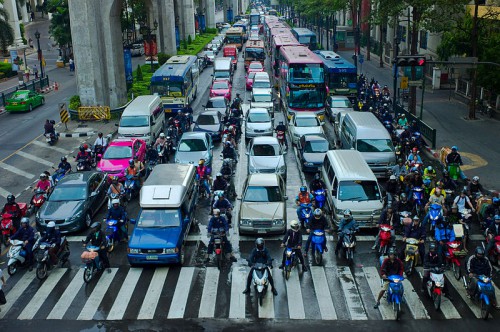A new study says lane splitting could be the global solution for motorcycle safety. Motorcycle safety researcher Steve Guderian compares instances of rear-end collisions in California – where lane splitting is not expressly prohibited – to states with similar riding seasons and number of riders. The data from NHTSA shows that California does have a lower rate of fatal rear-end motorcycle crashes when compared to other similar motorcycling states.
“Moving a motorcycle from behind traffic to a position next to traffic changes the risk to the motorcycle. All crash situations will comply with physical laws. Comparing the collision dynamics of a rear-end impact to a motorcycle involved in a lane-sharing accident reveals that lane-sharing represents a safer overall situation for motorcyclists. A motorcycle that is lane-sharing is no longer exposed to the full-force of a rear-end impact. Rather, the dynamic is more similar to a sideswipe lane-changing impact, which is an incomplete force contact.” says the study.
“The motorcycle and the car are basically traveling in the same direction so any contact between the two is limited to the minor motion of the car moving into the adjacent lane. This means there is a less forceful contact to the motorcycle and rider. When a motorcycle is stopped behind another vehicle and is impacted from the rear, the motorcycle and rider are exposed to an in-line contact. This corresponds with a full-force contact, where the full amount of the striking vehicle’s kinetic energy or momentum is transferred directly to the motorcycle. Consider a common 5 mph rear-end contact. An average motorcycle, weighing about 550 lbs. is completely stopped when it is struck on the rear-end by an average car, weighing about 2500 lb., traveling at about 5 mph. In this described dynamic, the motorcycle will be accelerated forward to a speed of about 4 mph in about one-tenth of a second. The chances are very high that the rider will be launched from the motorcycle in some manner, and will suffer injuries. In a lane-sharing crash the rider has a good chance of staying on the motorcycle instead of being thrown to the ground.” – it continues.
Some additional considerations when comparing a rear impact into a motorcycle with a lane change type of contact into a motorcycle;
1. In a lane change impact, the rider has a chance to recover and remain upright. This is unlikely in a direct rear-end contact.
2. In a lane change impact, the rider has a chance to take evasive action to avoid the contact altogether. This is unlikely in a rear-end impact.
3. If the rider does go down in a lane change contact, the potential injuries are not as severe as those in a direct rear-end contact.
In other words, when a motorcycle is lane-sharing if a crash with a vehicle does occur, the effects of the crash will most likely be less serious to the rider than a contact into the motorcycle rear end.” says Guderian.
via Ridetowork


